
-
Find the right food for your petTake this quiz to see which food may be the best for your furry friend.Find the right food for your petTake this quiz to see which food may be the best for your furry friend.Featured products
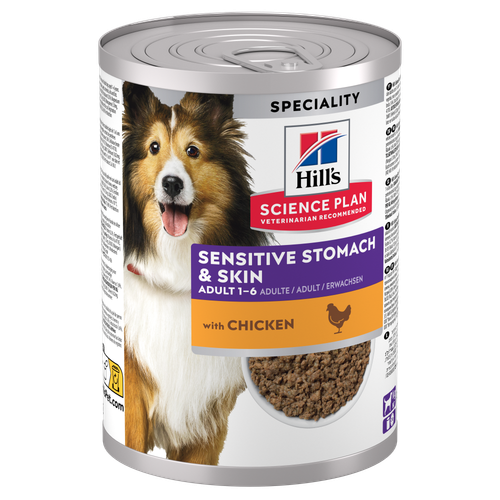 Sensitive Stomach & Skin Dog Food
Sensitive Stomach & Skin Dog FoodHill's Science Plan Sensitive Stomach & Skin Adult Wet Dog Food with Chicken is a complete premium dog food for adult dogs from 1 year. This savoury tinned loaf is enriched with ingredients that support digestive health & skin care.
Shop Now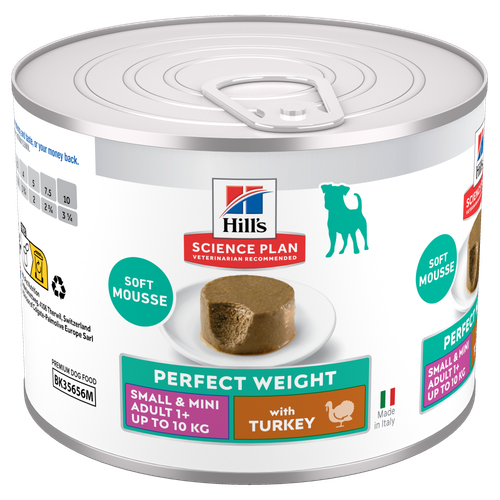 Perfect Weight Small & Mini Adult Dog Food
Perfect Weight Small & Mini Adult Dog FoodHill's Science Plan Adult Small & Mini Dog Food with Turkey is a complete premium pet food for adult small dogs from 1 year old that are prone to weight gain or slightly overweight. This deliciously smooth mousse is formulated to deliver the appropriate amount of energy to support weight maintenance in adult dogs.
Shop Now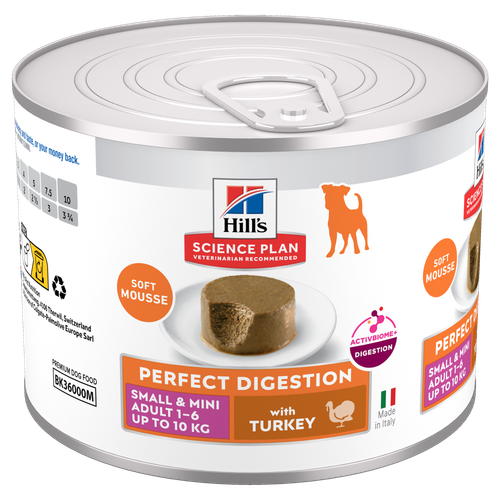 Perfect Digestion Small & Mini Adult Dog Food
Perfect Digestion Small & Mini Adult Dog FoodHill's Science Plan Perfect Digestion Small & Mini Adult Dog Food with Turkey is a complete premium pet food for small breed adult dogs aged 1–6 years. This deliciously smooth mousse is precisely balanced to deliver the appropriate amount of energy and to support digestive health in adult, small breed dogs.
Shop NowFeatured products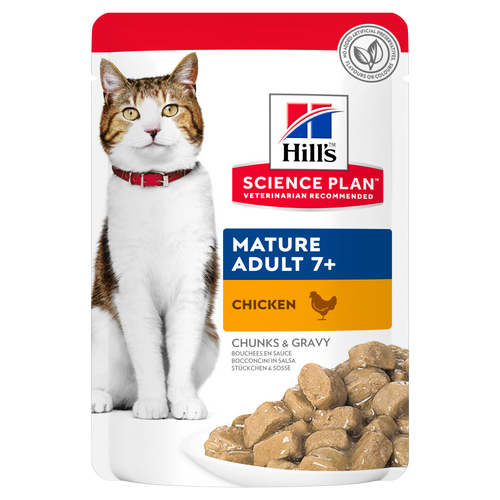 Mature Adult Wet Cat Food with Chicken
Mature Adult Wet Cat Food with Chicken
Tender chicken chunks in gravy for mature adult cats. Made with easy-to-digest ingredients, high-quality protein for lean muscle maintenance and antioxidant vitamins C+E for optimal health.
Shop Now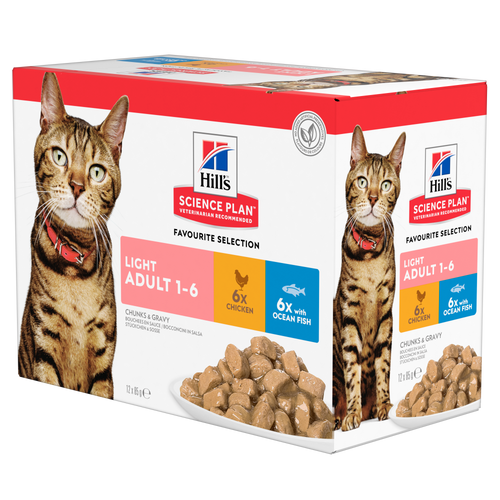 Light Adult Multipack Wet Cat Food with Chicken & Ocean Fish
Light Adult Multipack Wet Cat Food with Chicken & Ocean FishTender chicken chunks in gravy for cats, with L-carnitine and fewer calories for ideal weight management. Packed with high-quality protein, omega-6s, and vitamin E for shiny fur and healthy skin.
Shop Now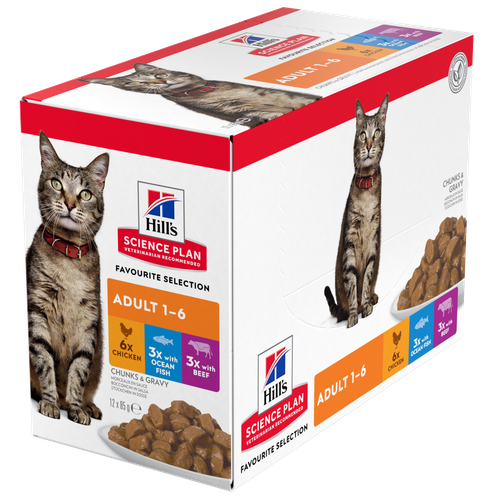 Adult Multipack Wet Cat Food with Beef, Ocean Fish & Chicken
Adult Multipack Wet Cat Food with Beef, Ocean Fish & ChickenTender chunks in gravy for cats, with high-quality protein to maintain lean muscle. With vitamin E and omega-3s & -6s for healthy skin and balanced minerals to support healthy vital organs.
Shop Now -
Dog
- Dog Tips & Articles
-
Health Category
- Weight
- Food & Environmental Sensitivities
- Urinary
- Digestive
- Joint
- Kidney
-
Life Stage
- Puppy Nutrition
- Adult Nutrition
- Senior Nutrition
Cat- Cat Tips & Articles
-
Health Category
- Weight
- Skin & Food Sensitivities
- Urinary
- Digestive
- Kidney
-
Life Stage
- Kitten Nutrition
- Adult Nutrition
Featured articles The Incredible Science Behind Your Pet's Microbiome
The Incredible Science Behind Your Pet's MicrobiomeLearn what your pet's microbiome is, how it contributes to your pet's gut and overall health, and why nutrition is important in maintaining healthy microbiomes.
Read More Show some love with wet foods: a great choice for pets with health issues
Show some love with wet foods: a great choice for pets with health issuesShow some love with wet foods: a great choice for pets with health issues.
Read More The Right Diet For Your Pet
The Right Diet For Your PetIn people, the right diet is very important. If you are eating the wrong way for your metabolism, activity level, age and lifestyle you could end up with health issues.
Read More -


Believe it or not, taking care of your dog's teeth is as important as looking after your own. Just like us, our dogs experience plaque build-up on their teeth. Plaque is a sticky layer on the teeth left by bacteria in the mouth. Plaque can be removed through brushing. However, if left alone, plaque becomes calcified and hardens into tartar. This is a hard yellowish-brown substance also known as calculus. All of this leads to inflamed gums (known as gingivitis), which is the onset of gum disease.
Gum disease can become the root cause of serious issues as your dog ages. It can cause teeth to fall out and lead to bacterial infection, which can affect vital organs if bacteria gets into the bloodstream. Taking care of your dog's teeth will not only lead to a healthier pet, but also help you avoid expensive dental bills. Fortunately, prevention and regular maintenance of your dog’s teeth are a fairly easy albeit vital habit to build. Here are our tips for building healthy routines and how to spot the potential signs of dental problems.
Tip 1. Tell-tale signs
Your vet will be able to spot any problems during your dog's annual check-up, but in the interim, here are some signs you should look out for:
- Yellow and brown tartar deposits on the teeth, usually near the gum line
- Difficulty eating or looking like they want to eat but walking away
- Swollen and bleeding gums
- Bad breath
Remember, dogs can have bad breath for a variety of health reasons, so don't dismiss a foul smell as plain old doggy breath. As the gateway to your pet’s stomach, it’s important you keep track of your dog’s dental and gum health to avoid dental disease or issues and spot any discomfort before it progresses.
Tip 2. Start brushing your dog’s teeth
Just as you take care of your own teeth, regular brushing, a good diet and regular check-ups help keep your dog’s teeth healthy. However, when you start brushing your dog’s teeth, it’s important that they don’t already have gum disease or teeth that need removing. Before embarking on any prevention protocol, get your dog’s teeth checked by your vet. They may need to have them professionally cleaned under anaesthetic. Once their gums are back in good condition, free of infection, inflammation or pain, then you can start brushing.


Tasty Tips
Use toothpastes specifically designed for pets. Human toothpastes are designed to foam up and be spat out. They are also often flavours that most animals don’t like. Use a toothpaste formulated for dogs instead. It will help your dog to accept the brushing and avoid an upset stomach. What about the toothbrush? Depending on the size of your dog's teeth and mouth, you may be able to use a regular toothbrush. There are also specially designed brushes that fit on your finger to make brushing easier.
However, you can always ask your vet for their advice. They may be able to give you a demonstration.
Tip 3. A regular cleaning routine
Brushing is easier if you begin while they are still young, but a dog of any age will eventually get used to it with patience and kindness. You should brush your dog's teeth at least once a week, but once a day is best.
Always start with plenty of reassurance to help calm them down. Let them have a tiny taste of the toothpaste, and then begin to gently brush their teeth in a massage-like motion. This allows them to get used to the sensation. It’s usually best to start with the molars at the back of the mouth, as the incisors at the front tend to be more sensitive.
When you brush, pay particular attention to where the tooth meets the gum. Your dog might not like it at first, but be patient, and you'll get there in the end.
Tip 4. Brushing alternatives
There are specially formulated dry dog foods and treats that can reduce tartar and avoid the onset of gum disease. These foods come in a larger kibble size, so your dog has to chew them and not just swallow them. They also have specially-aligned fibres that are proven to scrape the teeth clean and help prevent dental issues. Remember, never change your dog’s food without consulting your vet, and always introduce new food gradually over 5-7 days to avoid stomach upsets. The same as with brushing, don’t start these foods without your vet checking your dog’s teeth first. If they have inflamed or painful teeth and gums already, you could make it worse and put them off the food for good.
Remember, keeping your dog's teeth in good condition is essential for their overall health.
Reviewed by Dr. Hein Meyer, DVM, PhD, Dipl-ECVIM-CA and Dr. Emma Milne BVSc FRCVS.


One of our staff authors prepared this article for you
Related products
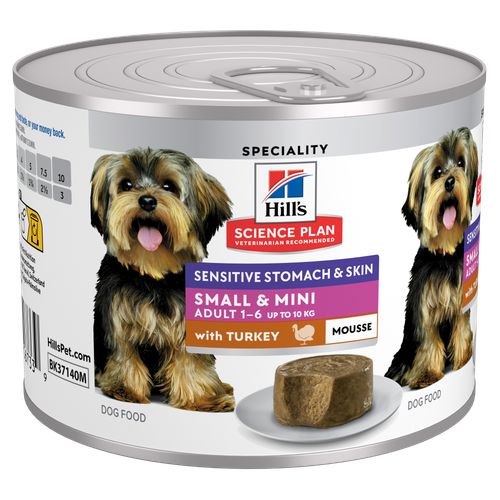
Hill's Science Plan Sensitive Stomach and Skin Small & Mini Adult Dog Food with Turkey is a complete premium pet food for small breed adult dogs aged 1–6 years. This deliciously soft mousse is enriched with ingredients that support digestive health & skin care.

Hill's Science Plan Perfect Digestion Small & Mini Adult Dog Food with Turkey is a complete premium pet food for small breed adult dogs aged 1–6 years. This deliciously smooth mousse is precisely balanced to deliver the appropriate amount of energy and to support digestive health in adult, small breed dogs.

Hill's Science Plan Sensitive Stomach & Skin Adult Wet Dog Food with Chicken is a complete premium dog food for adult dogs from 1 year. This savoury tinned loaf is enriched with ingredients that support digestive health & skin care.

Hill's Science Plan Adult Small & Mini Dog Food with Turkey is a complete premium pet food for adult small dogs from 1 year old that are prone to weight gain or slightly overweight. This deliciously smooth mousse is formulated to deliver the appropriate amount of energy to support weight maintenance in adult dogs.
Related articles

Many human foods are dangerous to dogs. Read about 5 of the worst toxic food offenders that can kill your dog - and how much it takes to hurt them.

Learn about the potential health risks of a raw diet for dogs and why they aren't the best option for your pup or you.

How, when and what to feed your new puppy is an important decision, learn more about the things to consider for feeding your puppy.

Learn effective tips for feeding a dog that's a picky eater and ensure proper nutrition for a finicky eater. Discover tips for pet parents at Hill's Pet UK.

Put your dog on a diet without them knowing
Our low calorie formula helps you control your dog's weight. It's packed with high-quality protein for building lean muscles, and made with purposeful ingredients for a flavourful, nutritious meal. Clinically proven antioxidants, Vitamin C+E, help promote a healthy immune system.
Put your dog on a diet without them knowing
Our low calorie formula helps you control your dog's weight. It's packed with high-quality protein for building lean muscles, and made with purposeful ingredients for a flavourful, nutritious meal. Clinically proven antioxidants, Vitamin C+E, help promote a healthy immune system.

